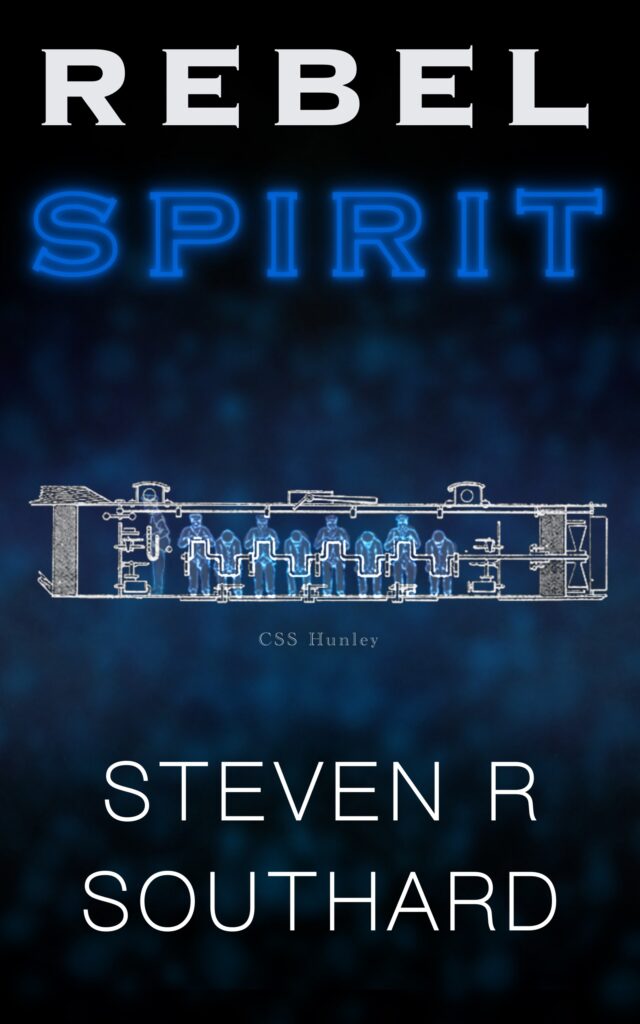On this anniversary, let’s observe a moment of silent reading while we visualize the events of the day some brave submariners made history.
Aboard the Submarine
You’re sitting on a bench, crammed in beside six other sweaty men. Your hands grip a crankshaft, and you turn it under the command of a lieutenant sitting at the bow, to your left. You face the boat’s starboard side three feet away, a blank, curved bulkhead of iron, now moist with condensation. Stale air fills your lungs with each breath. The odors of sweat, urine, oil, and pipe tobacco assault your nostrils.
“We’ve got ’er now,” the lieutenant says. “Dead ahead. For the South, men! Full speed!”
Though exhausted and out of breath, you rotate the crankshaft with all your strength. You’re determined to strike a blow for your side’s cause, and you’re confident of success.
You feel a powerful impact and hear a loud explosion.

CSS Hunley
By late 1863, the Confederacy searched for any advantage that might reverse the currents of the Civil War in its favor. The Union blockade of Charleston hindered vital supply lines, and seemed impenetrable. If the Grey could not defeat the Blue on the surface, what about underwater?
People had tried submarines in battle before, but never with success. Inventor Horace Hunley believed his boat stood a good chance to break the blockade. Forty feet long and four feet in diameter, CSS Hunley introduced the cigar shape common to all later military submarines. Armed with a keg of explosives mounted on a spar projecting from her bow, the craft aimed to ram its prey, blast a hole in its hull, and sink it.
Poor Performance Record
An innovative boat requires a well-trained crew, and they made frequent practice runs. Just as the men began to gain proficiency, tragedy struck. On August 29, 1863, a mishap occurred, killing five crewmembers, who sank with the craft.
Still, the Confederacy needed a victory, so they recovered the Hunley and obtained a fresh crew. This time, Horace Hunley himself, the craft’s inventor, manned the boat. They completed many test runs until, on October 15, the submarine flooded again, killing all eight men aboard.
After a boat kills two crews, most of us would abandon further tries. The desperation of the South, though, had reached a point beyond rational calculation of odds. They raised the boat once more, removed its dead, and somehow obtained a third crew.
Attack and Aftermath
On the night of February 17, 1864, that crew rammed the Hunley into the side of USS Housatonic. The spar-mounted keg exploded, crippling the Union ship and sinking her with the loss of five sailors. The boat’s crew had performed the first successful submarine attack in history.
People waited on shore for the Hunley, but the little submarine never returned. Some thought the craft got sucked into the hole it created, but that proved untrue. Searchers found the Hunley in 1995, and salvagers raised her in 2000. Today, she rests on display at a museum in Charleston.
Rebel Spirit
Yes, the Confederacy fought to preserve the vile institution of slavery and lost the war. Even so, we can still admire the bravery of those men in the Hunley. They volunteered to serve aboard an experimental craft that had already killed two crews. They endured horrendous conditions in a cramped iron tube, hoping to free their countrymen from a blockade when no other recourse seemed possible.
Having served on a submarine, I feel a kinship with the Hunley crews. I’ve written a ghost story called Rebel Spirit about one of the crewman. You can purchase it in ebook or paperback format.
Thank you for sharing, on this anniversary, a somber moment of remembrance for the CSS Hunley crew along with—
Poseidon’s Scribe

